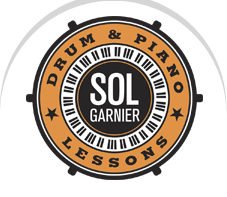The drum set is a very young instrument. Although there were some forms of dum set at the beginning of the 20th century, the instrument, as we know it, took its modern shape around the mid 1930’s with drummers like Gene Krupa. Little by little, after that, a drum set was more or less composed of a bass drum, a snare drum, a hi hat, a ride cymbal, one or two crash cymbal and, at least one Tom, more often than not, two toms. That has become the accepted configuration we are still seeing today. Gone were the wood blocks, the bells, the sock cymbals (an early hi hat whose cymbals were closed to the ground).
Of course, drummers these days, still use many different kind of percussion accessories, but if you say to the common man the word drum set, in his mind will pop the shape I just mention.
So, roughly, the drum set is about eighty years old.
And, as a drum teacher, I use a typical five piece set, the very kind I was taught on at Berklee College of Music.
This is very significant. We have crossed a borde because we now have one instrument to deal with. And with that configuration comes a library of exercises, of songs, of concepts, of methods to flesh up the study of the drum set.
For comparison, the piano was invented around 1700 but Johann Sebastian Bach approved the first piano in 1747. And the instrument was perfected up until the beginning of the 20th century. It’s greatest virtuosos, people like Chopin or Liszt came around the mid 1800.
Now, even if the drum set is much younger, we already have a plethora of incredible technician like Dave Weckl, Mike Mangini or Neal Peart that have pushed the possibilities of what can be done with four limbs.
By the same token, music schools around the world now have accepted the drum set in their roster of percussion instrument to teach to young pupils. Everyone recognizes the drum set and respects it.
And, the same as the piano has become an essential element of music education, I am suspecting that the drum set is about to get the same treatment. In one word, it is about to become academic.
I am very happy about this situation because, even back in the beginning of the 90’s, it was difficult in France, for example, to find schools where I could learn the drum set. It wasn’t yet seen as a valid vehicle for music in most conservatories.
So, here, I want to salute all the musicians who have worked to add this wonderful instrument to the ones we can proudly list in an orchestra. And, as a drum teacher, I am extremely happy to teach it. I always thought it deserved the same care and attention as a violin or a guitar.
